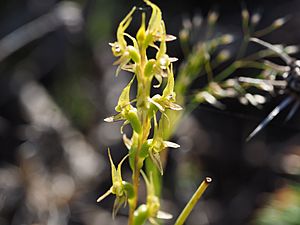Little laughing leek orchid facts for kids
Quick facts for kids Little laughing leek orchid |
|
|---|---|
 |
|
| Prasophyllum gracile growing on McGanns Rock near Hyden | |
| Scientific classification | |
| Synonyms | |
|
Prasophyllum macrostachyum R.Br. |
The Prasophyllum gracile, also known as the little laughing leek orchid, is a type of orchid. It grows only in the south-west part of Western Australia. This orchid is one of the most common and widespread orchids in that area. It has a single smooth, tube-shaped leaf and can have up to forty or more flowers, which are usually yellowish-green.
Contents
What it Looks Like
The Prasophyllum gracile is a plant that grows in the ground. It comes back year after year and loses its leaves in some seasons. It has an underground tuber (like a small potato) and one smooth green leaf. This leaf is shaped like a tube and can be 80–150 mm (3–6 in) long. It is about 2 mm (0.08 in) wide near the bottom.
This orchid grows a flowering stem that is 60–200 mm (2–8 in) tall. On this stem, there are usually between five and forty or more flowers. The flowers are yellowish-green, but sometimes they can be purplish. Each flower is about 7–10 mm (0.3–0.4 in) long and 5 mm (0.2 in) wide.
The bottom part of the flower, called the ovary, is oval-shaped and about 3.5 mm (0.1 in) long. The top part, called the sepal, is narrow and pointed, about 5 mm (0.2 in) long. The two side sepals are about 6 mm (0.2 in) long. They are joined together for about half their length. The petals are about 4 mm (0.2 in) long and curve inwards. The labellum (a special petal) is egg-shaped and about 3 mm (0.1 in) long. It has slightly wavy edges and curves upwards. You can see these orchids flowering from July to November.
How it Got its Name
The Prasophyllum gracile was first officially described in 1840 by a person named John Lindley. He wrote about it in a book called A Sketch of the Vegetation of the Swan River Colony.
The second part of its scientific name, gracile, is a Latin word. It means "slender" or "thin". This name refers to the thin, pointed tips on the side sepals of the flower.
Where it Grows
The little laughing leek orchid often grows in shallow soil. You can find it on granite rocks, but it also lives in other places. It grows all the way from Shark Bay in the north to Eyre in the south, near the Great Australian Bight.
Looking After This Orchid
The Western Australian Government's Department of Parks and Wildlife has looked at this orchid. They have classified it as "not threatened". This means it is not currently in danger of disappearing.
Images for kids



